
- Home Page
- Accepted
Paintings & Copies - Doubtful
Attributions - Doubtful Textual References
- Alternative
Titles - Collectors &
Museums - Bibliography
- Search Abecedario
- Watteau &
His Circle
Arlequin, Pierrot et Scapin (copy 1)
Entered May 2015; revised August 2015
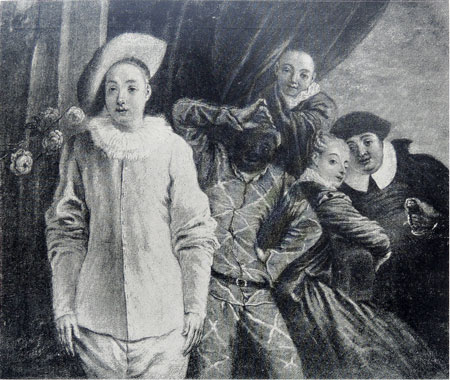
Althorp, collection of Charles Edward Maurice Spencer, the 9th Earl Spencer (b. 1964)
Oil on canvas
18.4 x 23.5 cm
ALTERNATIVE TITLES
Maskers
Pantomimical Figures
PROVENANCE
Collection Earl of Spencer at Althorp. Listed in the Catalogue of the Pictures at Althorp made in November 1802 as “Pantomimical Figures . . . “ [Watteau].” Paired with its pendant, “A Concert” (i.e., Pour nous prouver que cette belle). Neither work was listed in the 1742 and 1750 inventories of the Althorp paintings, suggesting that the acquisition of these paintings occurred in the second half of the eighteenth century. It was listed in the 1831 catalogue of Althorp as “Maskers” and coupled with its pendant, entitled “A Concert.”
By descent to the present owner.
SELECT BIBLIOGRAPHY
Zimmermann, Watteau (1912), no. 57.
Dacier, Vuaflart, and Hérold, Jean de Jullienne et les graveurs (1921-29), cat. 97.
Réau, “Watteau” (1928), under cat. 60.
Adhémar, Watteau (1950), cat. 163.
Brookner, “French Pictures at Waddesdon” (1959), 273.
Levey, “French and Italian Pictures” (1959), 57.
Waterhouse, Waddesdon Manor (1967), under cat. 135.
Macchia and Montagni, Watteau (1968), cat 155.
Ferré, Watteau (1972), under cat. B73.
Posner, Watteau (1984), 290.
Plock, “Pierrot, Harlequin and Scapin” (2011).
REMARKS
In the past some Watteau scholars—especially Zimmerman, Dacier, Vuaflart, and Hérold, and Adhémar—believed in the priority of the Althorp versions of Arlequin, Pierrot et Scapin and Pour nous prouver que cette belle. In accepting the Althorp versions, Dacier, Vuaflart, and Hérold were apparently unaware of the Waddesdon Manor picture and, as well, the pendant in the Wallace Collection. Zimmerman accepted the Althorp Arlequin, Pierrot et Scapin as the original but, curiously, rejected its pendant at Althorp, preferring instead the version in the Wallace Collection. Adhémar, although aware of the Arlequin, Pierrot et Scapin with the Frankfurt Rothschilds but only through Réau’s account, accepted the authenticity of the Althorp version but not its pendant there. However, the authorship of the Althorp pendants, together ever since their creation, cannot be divided. The physical evidence of the Waddesdon version of Arlequin, Pierrot et Scapin demonstrates that it is Watteau’s autograph work and all this early disarray, much of it caused by the lack of communication across the Channel, can now be passed over.
The provenance of the Althorp paintings has been confused with that of the primary works at Waddesdon Manor and the Wallace Collection. The whereabouts of the Althorp paintings in the eighteenth century are unknown. They are not recorded in the Althorp inventories of 1742 and 1750, but they must have arrived at Althorp in the second half of the eighteenth century since they were listed in situ in the 1802 inventory and have remained there ever since. Thus, any attempt, such as the one by Dacier, Vuaflart, and Hérold, to associate them with paintings sold in the nineteenth century must be rejected outrightly.
Arlequin, Pierrot et Scapin (copy 2)
Entered May 2015; revised August 2015
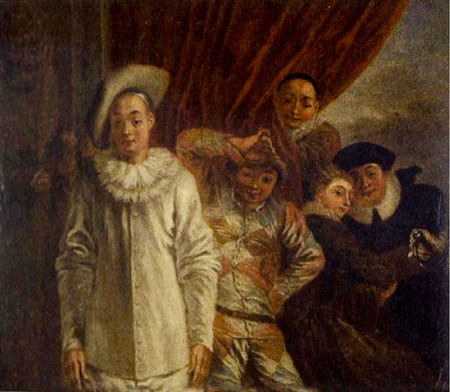
Moulins, Musée Anne de Beaujeu, inv. MI 1420.
Oil on panel
21 x 25 cm
PROVENANCE
Paris, collection of Dr. Louis La Caze (1798-1869; physician); donated to the Musée du Louvre; transferred by the museum in 1872 to its depot in Moulins.
EXHIBITIONS
Paris, Musée de la monnaie, Pélerinage (1977), cat. 178 (as by the École française du XVIIIe siècle, Arlequin, Pierrot et Scapin, lent by the Musée des beaux-arts, Moulins).
SELECT BIBLIOGRAPHY
Adhémar, Watteau (1950), under cat. 163.
Waterhouse, Waddesdon Manor (1967), under cat. 135.
Macchia and Montagni, L’opera completa di Watteau (1968), under cat. 155.Ferré, Watteau (1972), under cat. B73.
Faroult and Eloy, La Collection La Caze (2007), 277.
Plock, “Pierrot, Harlequin and Scapin” (2011).
Catalogue interministériel des Dépôts d'Oeuvres d'Art de l'Etat (2013).
REMARKS
When the celebrated collector Dr. La Caze owned this painting he apparently thought it was by Watteau himself. It was with this understanding that it was bequeathed to the Louvre along with La Caze’s many other masterpieces. After it was realized that the picture was only a copy, it was transferred to the Moulins museum in 1872. Since the mid-twentieth century when Watteau scholars became aware of this picture, they concured. Jean Lévy, former curator at the Louvre, is alone in having defended the priority of the Moulins painting (letter of January 13, 1959, in the Waddesdon Manor achives).
In Watteau’s version Harlequin wears the traditional dark-colored mask. The copyist responsible for this version painted an unmasked Harlequin, and his face reveals the unskilled nature of the copyist.
Arlequin, Pierrot et Scapin (copy 3)
Entered May 2015; revised August 2015
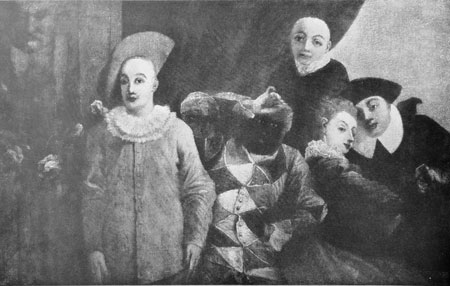
Whereabouts unknown
Materials unknown
Measurements unknown
PROVENANCE
Paris, collection of Pierre Amable Joseph (or Pierre Joseph Amable) Opigez (c. 1887)
.
SELECT BIBLIOGRAPHY
Braun, Catalogue général (1887), 160, no. 704.
Zimmerman, Watteau (1912), no. 139.
Dacier, Vuaflart, and Hérold, Jean de Jullienne et les graveurs (1921-29), under cat. 97.
Réau, “Watteau” (1928), under cat. 60.Adhémar, Watteau (1950), under cat. 163.
Waterhouse, Waddesdon Manor (1967), under cat. 135.
Macchia and Montagni, Watteau (1968), under cat. 155.
REMARKS
This copy is distinctively wide in relation to its height. It was photographed by Braun prior to 1887 and although Zimmerman published the image in 1912 as being in the Opigez collection, it is not certain that it was still there. No twentieth-century scholars seem to have seen the painting firsthand.
Arlequin, Pierrot et Scapin (copy 4)
Entered May 2015; revised August 2015

Whereabouts unknown
Materials unknown
Measurements unknown
ALTERNATIVE TITLES
Colombine, Pierrot et Arlequin
PROVENANCE
Paris, collection of M. de Wailly; his posthumous sale, Paris, Hôtel des ventes, February 17-18, 1853, lot 8: “Watteau (Composition gravée de). Colombine, Pierrot et Arlequin. Scène du théàtre Italien.” Sold for 51 francs.
REMARKS
This version may well be one that has come down to us, such as the one that La Caze could have bought in the 1850s or ‘60s, or the one that Opigez owned by at least the 1880s. But, lacking a more specific description of de Wailly’s picture, it is not possible to procede any further.
Arlequin, Pierrot et Scapin (copy 5)
Entered May 2015; revised August 2015
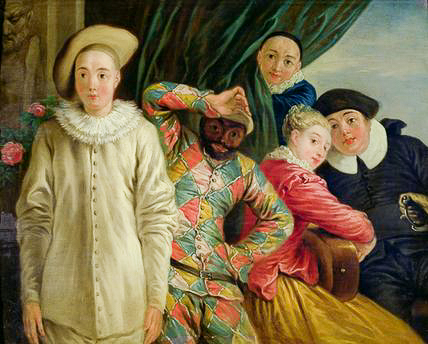
Private collection
Oil on canvas
24.5 x 28.5 cm
EXHIBITIONS
Paris, Musée de la monnaie, Pélerinage (1977), cat. 179 (as by the École française du XVIIIe siècle, Arlequin, Pierrot et Scapin, lent from a private collection).
REMARKS
While conforming to Watteau’s model in most respects, the copyist altered the herm at the left. More importantly, he changed Watteau’s color scheme—giving the woman a bright costume of red and yellow, Harlequin a much more intensely colored scheme of diamonds, and the curtain is green rather than the customary red. All this suggests that he worked from Surugue’s engraving rather than from Watteau’s painting.
Arlequin, Pierrot et Scapin (copy 6)
Entered May 2015; revised August 2015
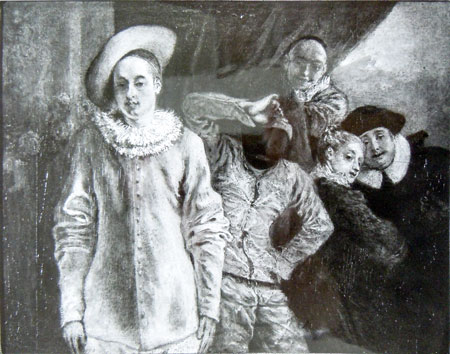
Whereabouts unknown
Oil on canvas
31 x 40.5 cm
PROVENANCE
Paris, Hôtel Drouot, July 3, 1986, lot 57: “WATTEAU, suite d’Antoine . . . ‘Arlequin, Pierrot et Scapin’. Peinture sur toile. (usures). 31 x 40,5. A rapprocher de la composition du Maître, cataloguée sous le no 155 de ‘Tout l’oeuvre peint de Watteau’ – Flammarion, 1970.”
Arlequin, Pierrot et Scapin (copy 7)
Entered May 2015; revised August 2015
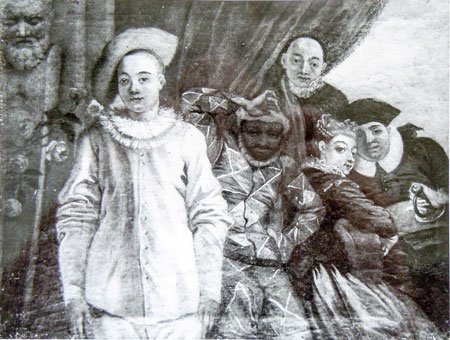
Gray, Musée Baron Martin
Oil on canvas
28.5 x 39 cm
PROVENANCE
Gray, Collection Edmond Pigalle (1844-1921); donated to the Musée Baron Martin in 1921.
SELECT BIBLIOGRAPHY
Mirimonde, Catalogue du Musée Baron Martin (1959), cat. 429.
Mirimonde and Davoine, Musée du Baron-Martin, Gray (1993), cat. 750.
REMARKS
In cataloguing this work in 1959, Mirimonde ascribed it to an imitator of Watteau working no earlier than the second half of the eighteenth century. But then he muddied the waters by questioning whether the composition engraved by Surugue was actually by Watteau. Instead, Mirimonde proposed that it was a pastiche after figures taken from diverse Watteau paintings and then perhaps brought together and painted by Philippe Mercier. This is a complicated and unnecessary hypothesis that has no basis in actuality. In the museum's 1933 catalogue, the picture was dated to the nineteenth century. The doubt as to Watteau’s authorship of the original composition was reiterated.
Modern Watteau scholars have apparently remained unaware of the picture in Gray.
Arlequin, Pierrot et Scapin (copy 8)
Entered May 2015; revised August 2015

Whereabouts unknown
Materials unknown
Measurements unknown
ALTERNATIVE TITLES
A Group of Five Masquerade Figures
PROVENANCE
City unknown, collection of a M. de Lattre.
Sale, London, February 25, 1897, lot 47: “Watteau . . . A group of five masquerade figures.” It was described as having previously been in the collection of a M de Lattre, and it was noted that it had been engraved.
SELECT BIBLIOGRAPHY
Dacier, Vuaflart, and Hérold, Jean de Jullienne et les graveurs (1921-29), under. cat. 97.
REMARKS
Except for Dacier, Vuaflart, and Hérold’s citation of this painting in an 1897 sale, it has not been possible to trace this picture further. No London sales for this date have been found and it has not been possible to identify M. de Lattre, the previous owner.
Arlequin, Pierrot et Scapin (copy 9)
Entered August 2015; revised February 2020

Whereabouts unknown
Oil on canvas
61 x 76.2 cm
PROVENANCE
Paris, collection of Charles Jean Goury de Champgrand, known as the marquis de Champgrand (1732 – 1799; military officer). His sale, March 11, 1776, lot 57: “VATTEAU . . . Plusieurs personnes déguisées en habits de caractère; l’une est en Arlequin dans un attitude grotesque, la main sur son chapeau; à côté de lui, est une femme en habit de Pierrot. Derrière eux, est une autre femme conversant, en jouant de la guitare avec un Scaramouche. Dans le fond, est un rideau rouge, sous lequel se laisse voir un Pantalon. Haut. 24 pouces, larg. 20 pouces. T.” Dacier and Vuaflart conjecture that the recorded width of 20 pouces is a mistake for 30 pouces (thus corresponding to the painting in the Devouge sale).
Paris, collection of Mathieu François Louis Devouge (b. c. 1745/50; art dealer). His sale, Paris, March 15ff, 1784, lot 118: “ANTOINE WATTEAU . . . Une composition de cinq figures de caractere du théâtre Italien, touchée avec esprit & d'une belle couleur. Hauteur 24 pouces sur 30. T.” Bought for 165 livres by Jacques Langlier (1730-after 1810; painting dealer).
London, with Henry Durlacher (1825-1902; art dealer).
London, collection of Thomas Baring (1799-1876; member of Parliament for Huntingdon).
EXHIBITIONS
London, Royal Academy, Old Masters (1871), cat. 176 (as by Antoine Watteau, Pierrot: a Group, lent by Thomas Baring, Esq.).
SELECT BIBLIOGRAPHY
Waagen, Treasures of Art in Great Britain (1854-57), 4: 96-97.
Dacier, Vuaflart, and Hérold, Jean de Jullienne et les graveurs, under cat. 97.
Réau, “Watteau” (1928), under cat. 60.
Adhémar, Watteau (1950), under cat. 163.
Macchia and Montagni, Watteau (1968), under cat. 155.
Posner, Watteau (1984), 2903 note 54.
Plock, "Pierrot, Harlequin and Scapin" (2011).
REMARKS
The owner of the collection of paintings sold in 1776 has traditionally been identified as the comte du Barry because a copy of the sale catalogue in the Rijksbureau voor Kunsthistorische Documentatie has that annotation on the cover. However, Burton Fredericksen at the Getty Provenance Index has established that the owner of the collection was “Verrier,” a pseudonym used by the marquis de Champgrand.
Champgrand’s picture has been associated with Arlequin, Pierrot et Scapin, particularly with the version that is now at Waddesdon. But a direct association cannot be correct. The description offered in the 1776 sale catalogue of the Champgrand collection errs in one curious way, namely it describes the Pierrot as being a woman whereas, of course, the characters is male. This aside, the exacting description in the Champgrand (and Devouge) catalogues fully accord with the composition of Arlequin, Pierrot et Scapin. However, the Champgrand and Devouge version of Watteau’s composition was on canvas and large sized, whereas Watteau’s Arlequin, Pierrot et Scapin was on panel and relatively diminutive.
Thomas Baring, the later owner of this picture, owned a number of paintings by or attributed to Watteau: a Garden Scene, a Marriage Fête, and a painting listed in Baring’s inventory under cat. 645 as Fete Champetre and listed in Baring’s ledger as Italian Clown and Troops. He identified it as having been bought in 1854 from the painting dealer Durlacher but, unfortunately, the early records of the Durlacher firm were destroyed in 1937. In his ledger, Baring described the painting as being engraved but did not indicate the title or the engraver’s name. The itinerant Dr. Waagen saw this picture in Baring’s London home in 1854 or 1856, in other words, soon after it had been purchased, and described it quite vividly and explicitly: “Pierrot, in his white dress, surrounded with ladies and cavaliers. The background is a garden. This picture, which is about two feet high by 3 ft. wide, is of such vivacity in the heads, clearness and warmth of colouring, and carefulness of execution, that I do not hesitate to pronounce it one of the most remarkable works of the master I know. It recalls the picture in my friend M. de Lacaze’s collection in Paris, only that there the figures as large as life.” The latter reference is to the great Gilles, now in the Louvre. When Baring exhibited his painting at the Royal Academy in 1874, its measurements were stated to be 24 x 30 inches. Given that the Champgrand, Devogue, and Baring pictures have similarly described subjects, all have the same exceptionally large size, and all are on canvas, there is every reason to believe that they are one and the same.
The later whereabouts of Baring’s picture are unknown. Although he never married and left his art collection to his nephew, the 1st earl of Northbrook, the painting des not appear to have descended to him. Indeed, in his lifetime Baring sold off some paintings privately.
Arlequin, Pierrot et Scapin (copy 10)
Entered June 2022; revised December 2023

Germany, collection DK
Oil on panel
Measurements unknown
REMARKS
This simplified, relatively modern copy of Watteau’s composition lacks, among other things, the character at the top of the pyramid of comedians and the statue at the left. The artist was evidently unfamiliar with the theatrical world and rendered the traditional white costume of Pierrot in brown. The anonymous copiest proudly initialed his work “LF” in the lower right.